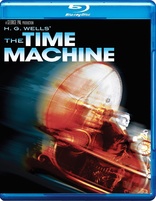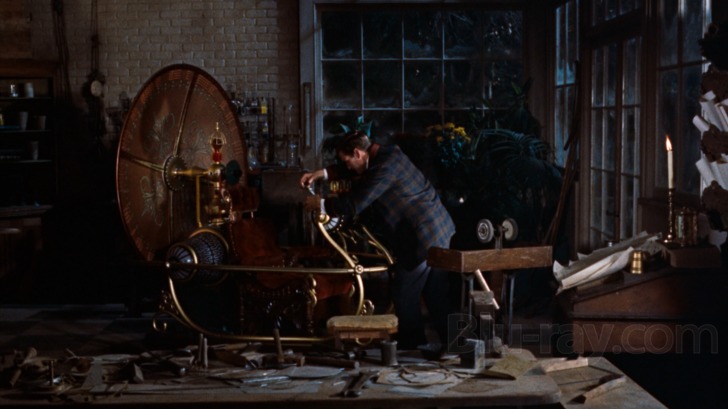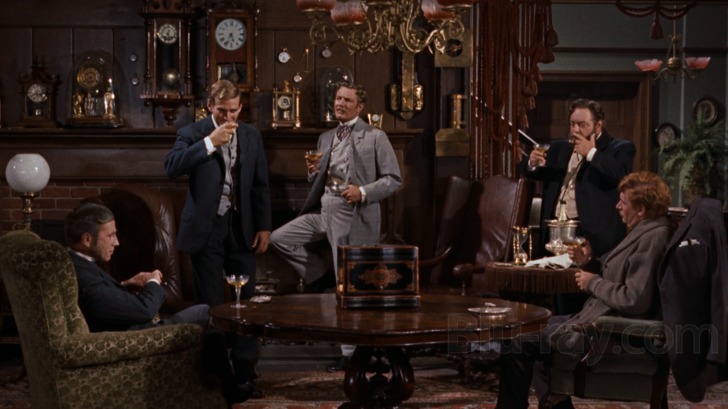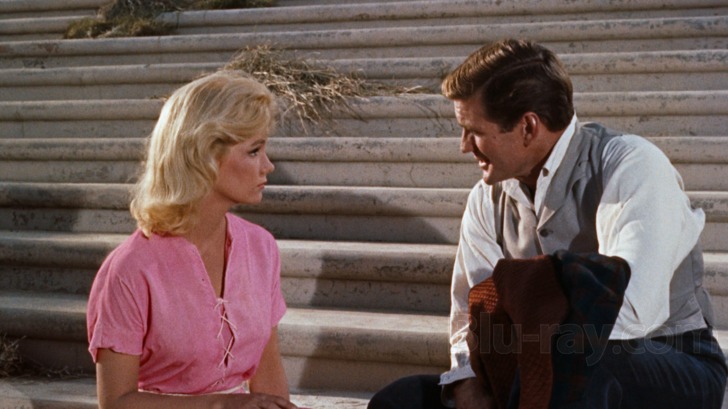The Time Machine Blu-ray Movie
HomeThe Time Machine Blu-ray Movie 
Warner Bros. | 1960 | 103 min | Rated G | Jul 08, 2014
Movie rating
7.7 | / 10 |
Blu-ray rating
| Users | 4.3 | |
| Reviewer | 3.0 | |
| Overall | 3.5 |
Overview
The Time Machine (1960)
A Victorian Englishman travels to the far future and finds that humanity has divided into two hostile species.
Starring: Rod Taylor, Alan Young, Yvette Mimieux, Sebastian Cabot, Tom HelmoreDirector: George Pal
| Thriller | Uncertain |
| Sci-Fi | Uncertain |
| Adventure | Uncertain |
| Fantasy | Uncertain |
| Romance | Uncertain |
Specifications
Video
Video codec: MPEG-4 AVC
Video resolution: 1080p
Aspect ratio: 1.78:1
Original aspect ratio: 1.85:1
Audio
English: DTS-HD Master Audio 5.1 (48kHz, 24-bit)
Spanish: Dolby Digital Mono
German: Dolby Digital Mono
Subtitles
English SDH, French, German SDH, Spanish
Discs
25GB Blu-ray Disc
Single disc (1 BD)
Playback
Region free
Review
Rating summary
| Movie | 4.0 | |
| Video | 3.0 | |
| Audio | 3.5 | |
| Extras | 2.0 | |
| Overall | 3.0 |
The Time Machine Blu-ray Movie Review
All the Time in the World (but Never Quite Enough)
Reviewed by Michael Reuben July 2, 2014Time travel has become such a staple of science fiction that the writers of various Star Trek series came to rely on it even before J.J. Abrams & Co. used it to reboot the franchise for the big screen. Although H.G. Wells' 1895 novel, The Time Machine, may not have been the first, it is generally regarded as the progenitor of time travel stories. Certainly no film has more influenced the cinematic sub-genre than George Pal's 1960 adaptation of the novel, which fired the imagination of generations of future filmmakers. Even today, when many of his sequences look primitive by comparison to modern effects, others still hold up, because they rely more on creativity than technology. Rarely has anyone come as close as Pal to conveying the child-like wonder of how it might feel to pass through time without being affected by it, watching it accelerate and decelerate, reverse and proceed, as easily as one might navigate a vehicle through space. Although Pal had found success in Hollywood as an animator and producer, including the 1953 adaptation of Wells's War of the Worlds, he was unable to interest any American studio in his idea for a film about time travel. The film was ultimately made, on an extremely tight budget, through the British arm of MGM. Warner now owns the film and is releasing it on Blu-ray.

Although the script for The Time Machine by David Duncan (Fantastic Voyage) retains Wells' initial Victorian setting and major plot elements, it refocuses the story on concerns that post-date the author's era, which preceded both World Wars and the nuclear age. It could be argued that Pal's film simply offers a variation of Wells' own pessimism, but perhaps that issue is best left for an ambitious Ph.D. candidate to disentangle. On January 5, 1900, a group of friends gather at the home of their scientist friend, George (Rod Taylor), for a dinner that was previously arranged on New Year's Eve, the last day of the 19th Century, when George first broached to the group the notion of time travel. Later in the film, the alert viewer will notice George's full name spelled out on a plaque in his time machine: "Manufactured by H George Wells". The group includes George's oldest friend, a red-headed Scotsman named David Filby (Alan Young); a skeptical fellow scientist, Dr. Philip Hilyer (Sebastian Cabot); a proper English gentleman who wants to hear none of this nonsense about time, Tom Helmore (Anthony Bridewell); and a dubious but curious colleague, Walter Kemp (Whit Bissell, who would later play a major role on the TV series, The Time Tunnel). As the hour for dinner draws near, their host is nowhere to be seen, but his housekeeper and cook, Mrs. Watchett (Doris Lloyd), bids the guests to be seated and start without him. Suddenly, George appears, as if from nowhere, disoriented, dirty and with ripped clothing. He proceeds to relate the incredible tale of his travels. A key element of The Time Machine is the counterpoint between Rod Taylor's effective narration, as George describes his travels, and director Pal's clever assembly of time travel effects, using a wide array of techniques, some traditional, others borrowed from animation. (The documentary, Time Machine: The Journey Back, which is included as an extra, provides a closer look at some of the effects.) Candles burn down, flowers bloom and die, fruit grows and ripens in an instant, and the mannequin in the window of Filby's Department Store across the street provides an ongoing commentary on women's fashion. Every so often, George pauses for a moment and steps out to examine his surroundings, usually at a time of war. Several times he encounters Filby's son, James (also played by Young), who ages, while George remains unchanged as he passes through time. After seeing the effects of nuclear war (which are among the film's most dated effects), a discouraged George flees thousands of years into the future for what is probably The Time Machine's most famous sequence: a future world divided between the placid Eloi, who inhabit an Eden-like surface where all their needs are provided for, and the fierce, ape-like Morlocks, who live underground and prey upon the Eloi. In Wells's novel, the opposition between Eloi and Morlocks was an obvious comment on English class distinctions, but in Pal's film, the relationship is more abstract and less obviously rooted in a particular historical context. The Morlocks' exploitation of the Eloi is a generic form of tyranny that can be analogized to many situations. George teaches the Eloi to resist, inspired in part by a growing attachment to the beautiful Weena (Yvette Mimieux). But he also needs to recover his machine, which the Morlocks have dragged into their sphinx-like temple behind apparently impenetrable doors. Since the film begins with George's arrival at his home in 1900 to tell his story, we know that he eventually recovers the device, but the exact circumstances are a mystery. And since George knows upon his return that the immediate future is grim, he faces a dilemma. What does he do next? More famous than any of the human characters in the film, or even the Morlocks, is George's time machine itself. Pal was intimately involved in its design, and no time travel device since then, not even Doc Brown's Delorean, has ever had such a distinctive personality. Warm, comfortable and inviting, its seat fashioned from a barber's chair, it is perhaps the least technological in appearance of any futuristic device in sci-fi cinema. Although it is supposed to have been designed by a bachelor married to his work, it bears the stamp of a maker who believes in gracious living, in stark contrast to the engines of warfare that dominate the future (and which some of George's friends urge him to develop as a more lucrative use of his talents). Periodically during his journey, George falls asleep at the controls of the machine, because it is an ideal resting place, while its huge dial studded with symbols whirs quietly behind the unconscious passenger. If for no other reason, The Time Machine has endured, because the titular device itself is the stuff that dreams are made of.
The Time Machine Blu-ray Movie, Video Quality 

No information was available on the source for Warner's 1080p, AVC-encoded Blu-ray of The Time Machine, but the results are problematic. The film contains many effects shots achieved through optical superimposition, and a degree of softness and loss of detail is to be expected with such scenes. But even basic live-action scenes shot in George's home or in scenes when George exits the time machine suffer from a lack of fine detail. The source elements appear to be in good condition, without scratches or damage, but it is possible they may be several generations away from the original camera negative, which might account for the weakness of the image. The usual suspect, so-called "DNR", cannot be blamed here, because the film's grain pattern is readily evident and has a natural appearance. It is possible, however, that some form of high-frequency filtering was applied to strip away fine detail, because the film's average bitrate is a miserly 19.95 Mbps, but if so, the filtering was done very neatly without leaving obvious artifacts. The only way to know for sure would be to compare the uncompressed master with the authored Blu-ray, which is an opportunity that none of us is likely to have. Whatever the cause, the Blu-ray's image is among the weakest of the catalog titles I have reviewed from Warner. It looks better in motion that it does in the screencaps, and it certainly doesn't deserve to be dismissed as an "upconvert" or as "DVD quality", but it is far from the best of which the studio is capable. Then again, if these are the best elements contained in the library of MGM films acquired from Turner Entertainment, a better version may not be possible. On the plus side, the blacks are good, and the colors are strong and well-saturated, which is an important element in the film's overall design, as George moves through different eras and watches his surroundings change. If nothing else, the Blu-ray's expanded color space allows The Time Machine's wide array of palettes to be seen in their full glory, which is no small advantage.
The Time Machine Blu-ray Movie, Audio Quality 

The Time Machine was released in mono, although IMDb lists a four-track stereo mix for the Westrex system. Whatever source was used, the Blu-ray's 5.1 remix, presented in lossless DTS-HD MA, is a modest affair, retaining the original's front orientation and using the stereo separation to expand the presence of Russell Garcia's (Perry Mason) score and a few of the time travel device's characteristic sound effects. The war sequences and the confrontations with the Morlocks have relatively limited dynamic range by contemporary standards. The dialogue is always clear.
The Time Machine Blu-ray Movie, Special Features and Extras 

Warner released The Time Machine on DVD in 2000. The trailer and The Journey Back have been ported over to Blu-ray, but the music-only track has been omitted.
- Time Machine: The Journey Back (480i; 1.33:1; 47:43): This video retrospective from 1993 falls into three parts, all of them hosted by Rod Taylor, both as himself and as George Wells. In the first part, Taylor recalls the experience of working with George Pal on The Time Machine and introduces interviews from some of the effects artists who created the illusion of time travel. In the second part, Taylor recounts the history of the film's most famous prop, including its use by Steven Spielberg to promote Back to the Future. In the third part, Whit Bissell and Alan Young reprise their roles as Walter Kemp and David Filby in a sort of coda to the film, as an aged George returns from the future just as World War I has commenced. The scenario is supposed to reflect Pal's own idea for a sequel for which he could never secure funding.
- Theatrical Trailer (480i; 1.33:1; 2:31): "What happens when boy meets girl, thousands of years from now?"
The Time Machine Blu-ray Movie, Overall Score and Recommendation 

To quote a former reviewer of my acquaintance, "I collect films, not discs." The Time Machine is one of the essential science fiction films of all time, and Warner's Blu-ray, despite a somewhat disappointing image, is the best presentation on home video to date and also the best we are likely to see for a long time. If I did not already have a review copy, I would be buying the film for my own library. That's as personal a recommendation as anyone can offer.
Similar titles
Similar titles you might also like

Journey to the Center of the Earth
Remastered | Limited Edition to 5000 | SOLD OUT
1959

Doctor Who: Complete Series 1-4
2005-2008

Fantastic Voyage
Fox Studio Classics
1966

Time After Time
Warner Archive Collection
1979

The Philadelphia Experiment
2012

Unknown World
To the Center of the Earth / Night Without Stars
1951

Forbidden Planet
Includes "The Invisible Boy" on SD
1956

Voyage to the Bottom of the Sea
Fox Studio Classics
1961

One Million B.C.
1940

Starflight One
1983

The Satan Bug
1965

Sword of the Valiant: The Legend of Sir Gawain and the Green Knight
1984

Greystoke: The Legend of Tarzan, Lord of the Apes
Warner Archive Collection
1984

World Without End
Flight to the Future / Warner Archive Collection
1956

The Time Machine
2002

The Eiger Sanction 4K
1975

The Big Trail
1930

The Mississippi Gambler
1953

The Covered Wagon
1923

MacKenna's Gold
1969